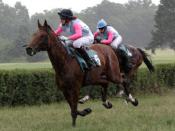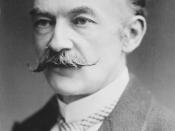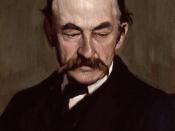With reference to at least four poems by Thomas Hardy, what do you think are the most notable features of Hardy's use of language and metrical form?
With a poet as prolific as Thomas Hardy, ample material is provided for academics to both praise and criticise. F.R. Leavis famously described Hardy as 'making a style out of stylelessness' (quoted from Haslam & Turton, language section). His poetry is certainly striking to the reader for its seeming awkwardness. His choice of words frequently demonstrates a tendency to mix colloquial and academic phrases. Hardy was well schooled in a variety of language: Latin, English, regional dialects (particularly Dorset dialect) and used a mixture of all of these in his poetry. His use of the latter underlies one theme recurrent to Hardy. He was dismayed by the impact of capitalism on rural communities and worried that the regional dialects would be eradicated.
The Bride Night Fire presents a vast array of colloquialisms: 'thirtover' (cross), 'tranted' (traded as a carrier), 'linhay' (lean to building) to name but a few. The language used depicts the poem's physical situation and enhances the presentation of the subject (which as the subtitle tells us is a 'Wessex Tradition'). Hardy was concerned about the decline of myths and legends as well as the language itself and this poem's language and theme represent his attempt to catalogue history.
Hardy's tendency to mix registers of language can also be seen in Channel Firing where he uses the word 'Christés' in verse 4. This archaic word has been criticised for having no justification other than a metrical one - he has simply used it to 'fit' . However, could this not be seen as skilful use of language rather than 'clumsy'? Haslam and Turton suggest:
....it is clear that ,


